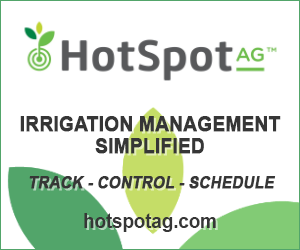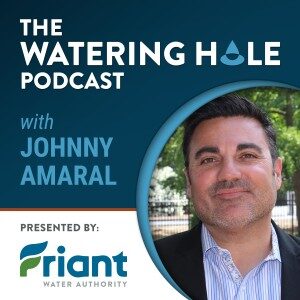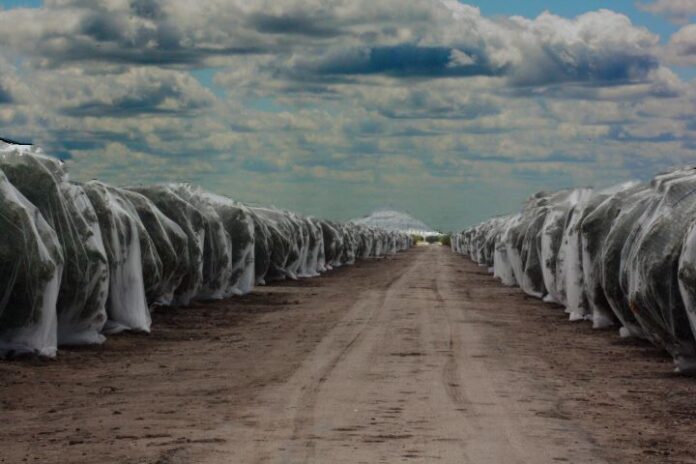 The Sustainable Groundwater Management Act is here. SGMA is an attempt by the legislature to fix a problem partly caused by the legislature and it is a reality, it is here and will impact everyone in the San Joaquin Valley in one way or another. Reduced surface supplies, decreased flood irrigation and a large expansion of tilled acreage have placed an overwhelming burden on our aquifer. Groundwater pumping has exceeded groundwater recharge for many parts of the Valley resulting in overdraft. Irreparable harm to the aquifer can take place. Removing too much groundwater can cause the land to sink, to compress upon itself, this is subsidence. Subsidence is just one of a half a dozen undesirable consequences SGMA is tasked to avoid.
The Sustainable Groundwater Management Act is here. SGMA is an attempt by the legislature to fix a problem partly caused by the legislature and it is a reality, it is here and will impact everyone in the San Joaquin Valley in one way or another. Reduced surface supplies, decreased flood irrigation and a large expansion of tilled acreage have placed an overwhelming burden on our aquifer. Groundwater pumping has exceeded groundwater recharge for many parts of the Valley resulting in overdraft. Irreparable harm to the aquifer can take place. Removing too much groundwater can cause the land to sink, to compress upon itself, this is subsidence. Subsidence is just one of a half a dozen undesirable consequences SGMA is tasked to avoid.
The state was divided into hydrological basins and subbasins. Most of Tulare County is in the Kaweah Subbasin. Along the eastern edge of the Valley the Sierra Nevada Range forms a boundary above ground and below. A granite shelf extends from the mountains to under the foothills. Groundwater in this type of geology is stored in cracks and voids in the rock. This is known as a fractured rock aquifer. Past this shelf the Valley floor is an alluvial plain where groundwater sits between the grains of sand, gravel and to some extend clay. SGMA only applies to this alluvial aquifer.
SGMA requires the formation of at least one Groundwater Sustainability Agency per subbasin to oversee the implementation of the law. The Kaweah Subbasin has three: the East Kaweah GSA, the Mid Kaweah GSA and the Greater Kaweah GSA. SGMA also requires each subbasin to develop a Groundwater Sustainability Plan to bring into a sustainable balance the amount of pumping and recharge of groundwater. This plan is divided into four, five-year segments with 2040 as the deadline year. As an example: the X Subbasin is pumping 10,000 acre feet per year and only recharges 5,000 a/f per year it will have to either reduce its pumping 5,000 a/f by 2040 or find a way to bring in an additional 5,000 a/f for recharge. The California Department of Water Resources is tasked with evaluating the GSPs. DWR has until the end of this year to give a response. Also, each subbasin no matter how many GSAs it contains can only submit one GSP.
Three GSAs
We asked the managers of the three GSAs in the Kaweah Subbasin for their opinions on how the SGMA process is going. Aaron Fukuda is the manager of the Mid Kaweah GSA, he’s also the General Manager of Tulare Irrigation District. The MKGSA includes TID and the Cities of Visalia and Tulare.
Michael Hagman is the manager of the East Kaweah GSA and General Manager of Lindmore ID. EKGSA includes the City of Lindsay, Exeter ID, Ivanhoe ID, Lindmore ID, Lindsay- Strathmore ID, Stone Corral ID, Lewis Creek Water District and Strathmore Public Utilities District.
Eric Osterling is the General Manager of the Greater Kaweah GSA. GKGSA includes: Kaweah Delta Water Conservation District, Kings County Water District, Lakeside Irrigation Water District, St. Johns Water District, Tulare County and California Water Service Company.
Q&A
SGMA is new to everyone. Are things going like you’d envisioned when you first started this endeavor?
AF – Yes and No. Yes – I think the GSAs understand the problems and are pursuing projects to try and alleviate the overdraft conditions in the Kaweah Subbasin. No – We thought that we would have 5 years (between 2020 and 2025) to try and fill some data gaps and establish a pumping allocation system. Unfortunately, 2020 and 2021 have been very dry and drought conditions have persisted, requiring an immense amount of groundwater to be pumped.
projects to try and alleviate the overdraft conditions in the Kaweah Subbasin. No – We thought that we would have 5 years (between 2020 and 2025) to try and fill some data gaps and establish a pumping allocation system. Unfortunately, 2020 and 2021 have been very dry and drought conditions have persisted, requiring an immense amount of groundwater to be pumped.
MH – Yes, but it appears that it will get more negative as we move forward.
EO – Yes and no. I’d always envisioned stakeholders would go to their corners and rattle their sabers a little, which has happened. But I also knew the best path forward was through coordination and maximizing economies of scale. That concept wasn’t immediately supported by most, but it’s definitely taken hold as we’ve rolled our sleeves up, developed our GSPs and begun to implement them. On the “no” side, I really don’t think any of us knew what we would face when it came to the hard stuff, i.e. groundwater allocations. In the Kaweah we’re all in the midst of doing just that and the cocktail of science, water law and economic and individual impact we’re having to consider is mindboggling.
What are the three things you’d like all your constituents to know about SGMA?
AF – One, SGMA is not going away and we must achieve sustainability for the future of agriculture and our communities.
Two, while we will be required to reduce our use of groundwater, those that have developed surface water supplies and have invested in conjunctive use operations will have the best resources to achieve sustainability.
Three, with the recent drought conditions, immediate reductions in groundwater pumping will be required to alleviate the excessive downward trend in our groundwater levels and give the Kaweah Subbasin the ability to achieve sustainability by 2040.
MH – One, absent regulation of the groundwater, we’d all be out of business.
Two, as far as the Kaweah Subbasin goes, our condition is a function of over-drafting the groundwater, it isn’t a take of surface water (aside from San Joaquin River Restoration Program).
Three, we will have to reduce our use of groundwater. There isn’t a supply of surface water the basin is connected to.
EO – I would agree with points made by Mr. Fukuda and Mr. Hagman. There seems to be a general belief that, as we are in our fledgling stages of implementation where there has been very little noticeable action to date for those not working intimately with the GSAs, that this regulation doesn’t have any teeth to it. That is not a wise assumption. In the midst of another prolonged drought, GSAs are being forced to accelerate schedules for capping groundwater pumping on as soft of a glidepath as possible to avoid the more draconian option of State intervention according to State law. Second, I think it’s important our stakeholders know that our boards and committees have been developed to include representative input into the process. In all cases, these decision-making bodies include individuals whom stand to be personally impacted by any decisions that are made. Lastly, unlike what you would likely see with the State backstop option under the law, local managers of surface and groundwater have compiled the greatest local minds in hydrology, hydrogeology, engineering, and economics that could possibly be assembled in order to most accurately inform a least impact strategy for compliance with the law.
managers of surface and groundwater have compiled the greatest local minds in hydrology, hydrogeology, engineering, and economics that could possibly be assembled in order to most accurately inform a least impact strategy for compliance with the law.
What are the three most important things your constituents can do to help your GSA to avoid undesirable outcomes?
AF – One, understand which GSA you are in and what water resources you have available to you.
Two, if you are a groundwater user only (no surface water) you should also understand your water consumption versus your water supply is not balanced and work with your local GSAs to determine what tools are available to overcome the difference between your water demands and water supplies. 
Three begin looking at your groundwater well as the most important tool in your agricultural operation and understand that it needs to be sustainable and reliable. Begin investing in the knowledge of your groundwater pumping operations, what supplies that groundwater, and how much water you use (meters).
MH – One, fully operate wet year water supplies into the Kaweah Subbasin.
Two, understand that the State isn’t the boogey man. We are our own problem and the State is telling us to fix it.
Three, prepare for reduced amount of available groundwater (efficient water applications is a start).
EO – I fully agree with points made by Mr. Fukuda and Mr. Hagman and have nothing to add. 
Has the state been helpful enough, what could it do better?
AF – In my opinion, the Department of Water Resources SGMA division has been exemplary. They have helped the GSAs get the information and finances in place to complete our 2020 GSPs. They also continue to be a valuable resource as we try and achieve sustainability under GSP implementation. I can regularly reach out to them with questions and receive answers immediately. They have also tried to include GSA managers in their discussions to they can better develop tools and guidance documents to ensure that they are helpful and not impede our sustainability goals. 
MH – Depends on how you view the problem. If we view the problem that the state is coming in here and taking our water supply, the answer is no. If one views this as a local problem that we need to take care of I think the state has been helpful. They have awarded us several grants that have aided or will aid the KSB in solving our local problem.
EO – As Mr. Fukuda and Mr. Hagman have stated, the Department of Water Resources and Governor’s Office have been exceptional in their support of GSAs through allocation and administration of funds, development of guidance documentation and a willingness to be available to answer questions as they come up (and there are many!). My only concern is avoidance of any preemptive policies or restrictions coming out of the State Water Resources Control Board, whom would be the agency to take over if the local option fails. As this is only the second year of implementation of our GSPs, the Legislature should also be considerate in allowing GSAs to show progress under current requirements without complicating an already complicated and monumental task with new regulations. 
How do you see Tulare County faring in the long term?
AF – Tulare County will no doubt lose some agricultural production. I can only speak for the Kaweah Subbasin, but we are trying to build tools that allow those that do not have surface water to either retire ground and have an alternative use, or secure enough surface water to salvage some ground for agricultural production. My faith is in the spirit of the farmer, which I believe is to achieve sustainability and to continue to produce food and fiber for the nation with less resources. The conversation I have with farmers is that while they do not like what is happening, they know that achieving sustainability for them is in their best interest. 
MH – I think it will be difficult for the next several years. But I believe we are a resilient people and will find ways of accomplishing our objectives to be sustainable.
EO – It’s going to be hard. Really hard for some. But I have faith in the resiliency of my community. The Central Valley has been burdened with layer after layer of regulation over the past few decades. Since agriculture stands to lose the most from this newest regulation, I’ll say that while some view the industry as flat-footed and immobile, I’m glass half-full and think it’s quite the opposite. Our goal is to create as much flexibility and time as possible to adjust. We’ve made it work before under existing regulations, and I think we can make it work here again.
regulation, I’ll say that while some view the industry as flat-footed and immobile, I’m glass half-full and think it’s quite the opposite. Our goal is to create as much flexibility and time as possible to adjust. We’ve made it work before under existing regulations, and I think we can make it work here again.
What question should I be asking you and what’s the answer?
AF – What is your GSA doing to address sustainability? The MKGSA looks at achieving sustainability through the lens of the Tulare Irrigation District. TID operates as a conjunctive use operation, meaning our growers pay land assessments and volumetric water rates to facilitate groundwater recharge operations and surface water irrigation. In wet years when there are large volumes of water available TID recharges the groundwater system through various resources, and in all other years (dry and average), TID growers use that groundwater as a backup to their surface water supplies. The MKGSA and TID intend to implement several projects to achieve any incremental increases in water supply by concentrating on investments in surface water storage projects, groundwater recharge basins, on-farm recharge, and surface water available on the open market. Any resource needs not met by our projects (essentially any future overdraft) will need to be offset by a reduction in farmed acreage, which is our last resort.
MH – Yes, a question for the writer to ask the reader. Are we overusing the groundwater in the KSB? The answer is yes. There are challenges outside of this basin that are result of less water moved from the Delta. In particular Westlands and the other federal and state water contractors that have been squeezed out of surface supply by actions of the state and federal government attempting to maintain two species in the delta. This has caused substantial harm to the folks who have spent a great deal of money and time to develop food for America. Delta efforts aside, the KSB (and probably the Tule Subbasin) are poster children of not living within their groundwater inflow means.
water contractors that have been squeezed out of surface supply by actions of the state and federal government attempting to maintain two species in the delta. This has caused substantial harm to the folks who have spent a great deal of money and time to develop food for America. Delta efforts aside, the KSB (and probably the Tule Subbasin) are poster children of not living within their groundwater inflow means.
EO – Yes again to what my colleagues have said. But I’m going to turn this one around a bit with a question I have no clear answer to. “How do you spell/define all of those alphabet soup water acronyms reported in your water meetings?” Understanding all of this is very complicated! I do this for a living and it’s at times confusing for even me. I couldn’t possibly expect the average stakeholder to understand even a fraction of all of this. You, and stakeholders, should be asking us (telling us) what you need from us to better understand this monster. Even with all of the GSA meetings you attend even you miss things. We have three GSPs for the Kaweah Subbasin alone that total over 4,000 pages. Not everyone can get to our many meetings. What more can we do to help you and the stakeholders we represent better understand our current condition, what we’re required to do, what they can or should be doing?
alphabet soup water acronyms reported in your water meetings?” Understanding all of this is very complicated! I do this for a living and it’s at times confusing for even me. I couldn’t possibly expect the average stakeholder to understand even a fraction of all of this. You, and stakeholders, should be asking us (telling us) what you need from us to better understand this monster. Even with all of the GSA meetings you attend even you miss things. We have three GSPs for the Kaweah Subbasin alone that total over 4,000 pages. Not everyone can get to our many meetings. What more can we do to help you and the stakeholders we represent better understand our current condition, what we’re required to do, what they can or should be doing?
My thanks to Messrs. Fukuda, Hagman and Osterling for taking time out of their very busy schedules to answer these questions. One place to find some hardcore SGMA information is at the Department of Water Resources’ page https://sgma.water.ca.gov/portal/
Editor’s note: Mr. Osterling makes a good point about the jargon used in the water world. A couple of years ago WaterWrights.net ran a list of acronyms and initials. It needs to be updated so don’t be shy, sent us your ideas. Here’s a link: https://waterwrights.net/2017/10/11/453/
DISCLAIMER OF RESPONSIBILITY; Waterwrights strives to provide clients with the most complete, up-to-date, and accurate information available. Nevertheless, Waterwrights does not serve as a guarantor of the accuracy or completeness of the information provided, and specifically disclaims any and all responsibility for information that is not accurate, up-to-date, or complete. Waterwrights’ clients therefore rely on the accuracy, completeness and timeliness of information from DAW entirely at their own risk. The opinions expressed in this report are those of the author and do not represent any advertisers or third parties.
ALL RIGHTS RESERVED. Copyright 2021 by WaterWrights.net/DAW

































